Introduction
The word allelopathy is derived from Greek word ‘allelo’ and ‘pathy’ which means mutual harm/suffering.1,2 Allelopathy is an intricate phenomenon in which plant releases its secondary metabolites into the surrounding which alter the germination and life processes of plants present in its vicinity.3 Secondary metabolites are the phytochemicals produced by the plant for its defense (either biotic or abiotic) and communications purposes such as to attract pollinators and are not used in their growth and development. Some of the invasive species releases these phytochemicals into the surrounding which alters the growth of surrounding community. This helps the former to establish itself via suppressing the other species.4
Eupatorium adenophorum Spreng. Syn. Ageratina adenophora (Spreng.) King and Robinson, also known as crofton weed (Asteraceae) is an invasive perennial herbaceous plant native to Maxico and Central America.5–8 The production of large number of small seeds with high germination rate enabled this species to spread as a serious weed almost all over the world and established in various types of ecosystems. The photochemical screening disclosed the existence of various types of phytotoxins in A. adenophora which shows suppressive effect against other plants.7–8
This plant is invading almost all types of ecosystems either it is a forest ecosystem, grassland ecosystem or the agroecosystem very rapidly, which can alter soil fertility, grain yield and productivity. With the introduction of invasive species, the native biodiversity is being disturbed, which can ultimately lead to biodiversity loss.9-12 Many studies have shown the allelopathic effect of A. adeonophora on the germination and growth processes of different plant species including rice.13-15 However the impact of A. adeonophora on the seed germination and early seedling establishment of rice (Oryza sativa L.) varieties in Central Himalaya is not well understood. Therefore, this study was accomplished to ascertain the allelopathic effects of water extracts of A. adeonophora on two rice varities. Rice crop was selected because it is a staple food for more than half of the world’s population16 and grown on161 million hectares with an average annual production of 678,7 million tones.17-18 The objectives of this study were:
To compare the allelopathic potential of aquous extracts of leaf (fresh and dry) and root (fresh and dry) on seed germination and early seedling growth of selected rice varieties.
To compare the resistant potential of selected rice varieties against leaf (fresh and dry) and root (fresh and dry) extracts of A. adeonophora.
Materials and Methods
A. Collection of Rice Seed Varieties
The seeds of two rice varieties viz. 6444 and 2245 (hereafter referred to as V I and V II, respectively) were collected from G.B. Pant University of Agriculture & Technology. Pantnagar, Uttarakhand, and tested for seed viability. The healthy seeds of each variety were selected, washed and sterilized. Experiments were conducted in the Ecology laboratory, Department of Botany, DSB Campus, Kumaun University, Nainital, Uttarakhand, India.
B. Preparation of Aqueous Leaf Extract
Leaves were separated from healthy plants of A. adenophora and ground to fine paste. For dry extract preparation, mature and healthy green leaves were collected, air-dried at room temperature and ground to fine powder. Following Das et al.,15 20g paste/powder was soaked in 200 ml distilled water separately at room temperature (200C±50C) for two days to obtain fresh and dry leaf extracts. The leaf extracts were filtered through Whatman filter paper No. 1 to remove impurities. These extracts were used as stock solution of 100% concentration and diluted to 50% concentration for conducting the experiment at two different concentrations. A treatment of distilled water was set as the control.
C. Preparation of Aqueous Root Extract
To prepare fresh root extract, roots of A. adenophora were collected from the field, washed to remove soil particles and ground to a fine paste. 20 g paste was soaked in 200 ml distilled water at room temperature for two days to obtain the root extract. The extract was filtered through Whatman filter paper No. 1. To prepare the dry root extract, washed roots were cut into pieces and air dried at room temperature (20oC±5oC). The dried roots were ground in a grinder and after sieving a fine powder was prepared, stored in air tight plastic bags. Further aqueous extracts of roots were prepared similar to the method followed in fresh extract preparation. From the 100% stock solution, 50% solutions were then made. A treatment of distilled water was set as the control.
D. Experimental Design
Petri-dishes were washed with tap-water, dried and sterilized with acetone. These Petri-dishes were then kept in oven at 1000C for 1 hour for further sterilization. Ten seeds were spread on sterile filter paper in each Petri dish (9cm diameter/lined with two sterile filter paper). The Petri-dishes were arranged in a complete randomized block design with 10 seeds per Petri dish and three replicates per treatment. 5 ml aqueous extract of each concentration (50% and 100%) was added to each Petri-dish separately. Similarly, the controls were treated with distilled water. Germination tests were conducted in 12 h light/dark cycles for 15 days with 150C minimum and 250C maximum temperature. The germination data were recorded on daily basis. A seed was considered germinated when the length of emergence reached 2 mm long. The root and shoot length were measured on the 15th day. Shoot and root dry weights were recorded after oven drying at 60⁰C for 48h. Germination percentage and germination rates were calculated following Raun et al.,19 relative water content following Sumithra et al., 20 seed vigor index according to Abdul et al., 21and Response index following Williamson et al.22
E. Statistical Analysis
The average data recorded was analyzed with ANOVA (Analysis of Variance) and Duncan’s test was used to compare the difference between means. Statistical analysis was performed by using SPSS version 16.
Results and Discussion
A. Germination and Seedling Vigor
The aqueous extracts of A. adenophora exerted an inhibitory allelopathic effect on seed germination and seedling growth parameters as compared to the control (Table 1 and 2). It was observed that with increasing the concentration of both fresh and dry leaf extracts, the inhibitory effect also increased. As compared to fresh extracts the dry aqueous extracts were more inhibitory (Table 1) and the seed of both the varieties could not germinate at 100% concentration extract of dry leaf. Seed germination, germination rate and seed vigour was increased by treatment with root aqueous extract at 50% concentration, while it decreased at 100% concentration as compared to control. Fresh aqueous extract of root at 50% concentration also increased seedling growth while dry aqueous extract caused decrease in all the observed parameters with increasing concentration (Table 2).
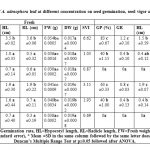 |
Table 1: Effect of aqueous extract of A. adenophora leaf at different concentration on seed germination |
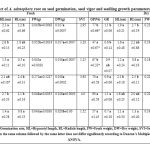 |
Table 2: Effect of aqueous extract of A. adenophora root on seed germination |
B. Hypocotyl and Radicle Length
Hypocotyle and redicle length of both the rice varieties were significantly affected by fresh and dry leaf and root aqueous extracts (Table 1 and 2). Maximum length of hypocotyls and radicle was reported at control treatment and decreased significantly (p˂0.05) with increasing concentration of aqueous extracts of leaf and root. Leaf extract was found to be more inhibitory than the root extract and inhibition caused by dry extract was more as compared to fresh extract.
C. Seedling Biomass
Fresh aqueous extract of leaves reduced the fresh weight (FW) of seedling in both varieties with increasing extract concentration while the effect on dry weight (DW) was not recorded. Dry leaf extract significantly affected the fresh and dry weights in both varieties. Seedling biomass showed upto 80% inhibition in fresh leaf extract and up to 100% inhibition in dry leaf extract at 100% concentration (Fig. 1).Fresh root extract showed variable results in both varieties while dry root extract decreased the fresh as well as dry weight of the seedling with increasing concentration (Fig. 2). Control treatment showed maximum fresh and dry weight.
When the data was analyzed for fresh weight percentage reduction (FWPR) and dry weight percentage reduction (DWPR) in seedlings due to allelopathic effect of A. adenophora, maximum reduction percentage was observed in 100% dry leaf extract in variety 6444 following fresh leaf treatment and dry weight percentage reduction did not show any significant result (Fig.1). Dry root extract showed increasing pattern of FWPR and DWPR in both the varieties where 100% treatment showed maximum inhibition. Fresh root extract increased the fresh weight as well as dry weight of variety 6444 while in variety 2245 the inhibition was higher due to the fresh root extract. In the fresh root extract, the dry weight of both the varieties showed increasing pattern (Fig. 2).
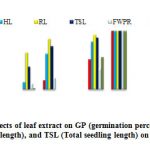 |
Figure 1: Inhibitory effects of leaf extract on GP (germination percentage) |
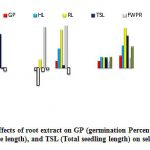 |
Figure 2: Inhibitory effects of root extract on GP (germination Percentage) |
D. Other Parameters
This study shows that response of rice varieties along the concentration gradient i.e., response breadth (RB) in fresh leaf and root extract was high (≈0.97-0.99) while dry leaf and root extract had low values (≈0.59-0.63). The dry leaf extract had the lowest values of RB in comparison to the dry root extract. Relative water content (RWC) decreased with increasing concentration of fresh leaf as well as root extract while in dry leaf extract RWC was highest in 50% concentration followed by control and 100% solution showed lowest RWC (0%) in both the varieties. Treatment with dry root extract showed increasing pattern of RWC in both varieties with increasing concentration.
This study demonstrated that under allelopathic effect, significant variations were observed among different varieties of the same species. Seed germination is an essential process in plant development that results in high crop production. The present study showed the suppressive effect of A. adenophora on the germination, fresh weight, dry weight, relative water content, hypocotyl length, radicle length, total seedling length and seed vigor index of rice var. 6444 and 2245. The inhibition effect was significantly increased with increasing concentration of the solution, indicating that the effect of plant allelopathy depends on the concentration of the extract solution. Many authors23–28 also reported increased inhibitory effect with increasing concentration of extract. This study also showed that the effect of fresh and dry leaf extract was more allelopathic in comparison to the fresh and dry root extract. Similar results were also reported by Namvar et al.29 In this study, although inhibition effects were recorded in the rice varieties mentioned above, surprisingly seed germination and seedling growth was found to be enhanced by the fresh root extract. Achakzai et al.30 reported that weed imposed inhibitory as well as stimulatory allelopathic effect on crop plants and more phytochemicals are present in leaves as compared to roots of same plant species.
When data of fresh and dry extracts were compared, aqueous extract of dry leaves had more potent inhibitory effect on germination percentage and seedling growth in both varieties of rice. ANOVA (Table 3) of leaf extract showed that treatments (extract concentrations) had significant effect on HL, RL, GP, and GR; extract type (Fresh and dry) showed significant impact on HL, GP, GR, FW and DW. Muhammad and Majeed31 also reported that air dry sunflower (Halianthus annuus L.) aqueous extracts caused higher inhibition on growth performance of wheat (Triticum aestivum L.) as compared to the fresh extract. Similarly, the brown dry leaf extract of Psidium guajava had more inhibition on Cassia occidentalis L. than the green fresh extract32. According to Achakzai et al., 30 dry plant material gives free bonding of solvent with the photochemicals and increase surface area for release of photochemicals as compared to fresh plant material.
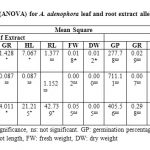 |
Table 3: Analysis of Variance (ANOVA) for A. aden- ophora leaf and root extract allelopathy investigated for two rice varieties. Click here to View Table |
Table 4: Correlation analysis of different treatments of A. adenophora on rice varieties
|
|
Variables |
Extract |
Species |
Treatment |
SL |
RL |
GP |
GR |
|
Leaf |
Extract |
1 |
|
|
|
|
|
|
|
Species |
0.000 |
1 |
|
|
|
|
|
|
|
Treatment |
0.000 |
0.000 |
1 |
|
|
|
|
|
|
HL |
-0.424** |
-0.047 |
-0.708** |
1 |
|
|
|
|
|
RL |
-0.165 |
-0.151 |
-0.823** |
0.857** |
1 |
|
|
|
|
GP |
-0.634** |
-0.035 |
-0.604** |
0.741** |
0.648** |
1 |
|
|
|
GR |
-0.462** |
-0.114 |
-0.755** |
0.898** |
0.878** |
0.918** |
1 |
|
|
Root |
Extract |
1 |
|
|
|
|
|
|
|
Species |
0.000 |
1 |
|
|
|
|
|
|
|
Treatment |
0.000 |
0.000 |
1 |
|
|
|
|
|
|
HL |
-0.350* |
-0.009 |
-0.495** |
1 |
|
|
|
|
|
RL |
0.152 |
0.091 |
-0.743** |
0.707** |
1 |
|
|
|
|
GP |
-0.165 |
0.264 |
-0.182 |
0.380* |
0.318 |
1 |
|
|
|
GR |
-0.120 |
0.057 |
-0.369* |
0.667** |
0.567** |
0.873** |
1 |
*Correlation is significant at the ≤ 1% level and ** Correlation is significant at the ≤ 5% level
Significant negative correlations were found between extract and HL, GP, GR; treatment and HL, RL, GP, GR; HL and RL, GP, GR; RL and GP, GR; GP and GR (Table 4) in leaf extract. Similarly, in root extract significant negative correlations were observed between extract and HL; treatment and HL, RL; HL and RL, GP, GR; RL and GR; GP and GR. The correlation indicates the phytotoxic effects of the extracts.
Conclusion
This study demonstrated the suppressive effect of leaf and root aqueous extracts of A. adenophora on the seed germination, growth of seedling, seedling dry mass and seedling vigor index of rice varieties 6444 and 2245. The inhibitory effect significantly increased with increasing concentration of extracts indicating that the effect of plant extracts depends on their concentration. Comparing data with fresh and dry leaf and root extract, aqueous extract of dry leaves and roots of A. adenophora had more potent inhibitory effect on germination percentage, seedling vigor index, seedling growth and biomass in both the varieties of rice. Among the two varieties investigated rice variety 6444 is more resistant to leaf extract while 2245 variety was more resistant to root extract. Based on the results obtained in our study, it could be concluded that A. adenophora caused a phytotoxic effect on test crops by releasing water soluble phenolics, which may serve as possible allelopathic agent to establish its allelopathy. However further studies are required to evaluate the inhibitory effects of A. adenophora under field conditions.
Acknowledgement
We are thankful to the Head, Department of Botany for providing necessary facilities. We also thank both the reviewers and concerned editor for their closer look in to the manuscript and valuable suggestions made.
References
- Hadi F, Naila S, Ibrar M, Rashid A. Allelopathic impact of Phragmites karka on seed germination and radical and plumule growth of wheat variety sirin-2007. Scholarly Journal of Agricultural Science. 2014; 4(7): 427-431.
- Trounce B, Dyason R. Crofton Weed. NSW Agriculture, Agfact. 2003; P7.6.36.
- Callaway RM. The detection of neighbors by plants. Trends in Ecology and Evolution. 2002; 17(3): 104–105.
- Parihaar RS, Bargali K, Bargali SS. Ecological attributes of some invasive plant species of Jhirna range in Corbett National Park Ramnagar, Uttarakhand. Journal of Plant Development Sciences. 2013; 5(4): 447-451.
- Auld BA. The distribution of Eupatorium adenophorum on the far north coast of New South Wales. Journal and Proceedings of the Royal Society of New South Wales. 1969; 102: 159-161.
- Tripathi RS, Singh RS, Rai JPN. Allelopathic potential of Eupatorium adenophorum, a dominant ruderal weed of Meghalaya. Proceedings of the Indian National Science Academy. 1981; 47(3): 458–462.
- Tripathi YC, Saini N, Anjum N, Verma PK. A Review of Ethnomedicinal, Phytochemical, Pharmacological and Toxicological Aspects of Eupatorium adenophorum Asian Journal of Biomedical Pharmaceutical Sciences. 2018; 8(66): 25-35.
- Liu PY, Liu D, Li WH. Chemical constituents of plants from the genus Eupatorium (1904–2014). Chemistry & Biodiversity. 2015; 12(10): 1481–1515.
- Bargali SS, Singh RP, Singh SP. Structure and function of an age series of eucalypt plantations in Central Himalaya, II. Nutrient dynamics. Annals of Botany. 1992; 69: 413-421.
- Bargali SS, Singh RP, Joshi Mukesh. Changes in soil characteristics in eucalypt plantations replacing natural broad leaved forests. Journal of Vegetation Science 1993; 4: 25-28.
- Bargali SS. Efficiency of nutrient utilization in an age series of Eucalyptus tereticornis plantations in the tarai belt of Central Himalaya. Journal of Tropical Forest Science. 1995; 7(3): 383-390.
- Bargali SS, Bargali Kiran. Diversity and biomass of the under story vegetation in an age series of Eucalyptus tereticornis International Journal of Ecology and Environmental Sciences. 2000; 26: 173-181.
- Ma J, Xing G, Yang W. Inhibitory effects of leachate from Eupatorium adenophorum on germination and growth of Amaranthus retroflexus and Chenopodium glaucum. Acta Ecologica Sinica. 2012; 32(1): 50–56.
- Zhang F, Guo J, Chen F, Liu W. Identification of volatile compounds released by leaves of the invasive plant croftonweed (Ageratina adenophora; Compositae), and their inhibition of rice seedling Weed Science. 2017; 60(2): 205–211.
- Das MBB, Acharya BD, Saquib M, Chettri MK. Effect of aquous extract and compost of invasive weed Ageratina adenophora on seed germination and seedling growth of some crops and weed. Journal of Biodiversity Conservation and Bioresource Management. 2018; 4(2): 11-20.
- Vibhuti, Shahi Charu, Bargali Kiran, Bargali SS. Seed germination and seedling growth parameters of rice (Oryza sativa) varieties as affected by salt and water stress. Indian Journal of Agricultural Sciences. 2015; 85(1): 102-108.
- Bargali SS, Bargali Kiran, Singh Lalji, Ghosh L, Lakhera ML. Acacia nilotica based traditional agroforestry system: effect on paddy crop and management. Current Science. 2009; 96(4): 581-587.
- Vibhuti, Shahi Charu, Bargali Kiran,Bargali SS. Assessment of salt stress tolerance in three varieties of rice (Oryza sativa L.). Journal of Progressive Agriculture. 2015; 6(1), 50-56.
- Raun WR, Solie JB, Johnson GV. Improving nitrogen use efficiency in cereal grain production with optical sensing and variable rate application. Agronomy Journal. 2002; 94(4): 815–820.
- Sumithra K, Jutur PP, Carmel BD, Reddy AR. Salinity-induced changes in two cultivars of Vigna radiata: responses of antioxidative and proline metabolism. Plant Growth Regulation. 2006; 50(1): 11–22.
- Abdul-Baki AA, Anderson JD. Viability and Leaching of Sugars from Germinating Barley 1. Crop Science. 1970; 10(1): 31–34.
- Williamson GB, Richardson D. Bioassays for allelopathy: measuring treatment responses with independent controls. Journal of Chemical Ecology. 1988; 14(1): 181–187.
- Chimouriya S, Shrestha I, Piya S, Lamichhane J, Gauchan D. Allelopathic effects of Adhatoda vasica and Eupatorium adenophorum on germination and growth behavior of Capsicum annum. International Journal of Innovative Science and Research Technology. 2018; 3: 362–368.
- Debnath G, Das P, Saha AK. Allelopathic effect of Clerodendrum infortunatum leaf extract on seed germination and seedling growth of some Agricultural crops of Tripura, India. International Research Journal of Pharmacy. 2017; 8(1): 46–49.
- Enyew A, Raja N. Allelopathic Effect of Lantana camara Leaf Powder on Germination and Growth Behaviour of Maize, Zea mays Linn. and Wheat, Triticum turgidum Linn. Cultivars. Asian Journal of Agricultural Science. 2015; 7(1): 4–10.
- Katoch R, Singh A, Thakur N. Allelopathic influence of dominant weeds of North-Western Himalayan region on common cereal crops. International Journal of Environmental Sciences. 2012; 3(1): 84–97.
- Mahmoud A, Singh SD, Muralikrishna KS. Allelopathy in Jatropha plantation: Effects on seed germination, growth and yield of wheat in north-west India. Agriculture, Ecosystems and Environment. 2016; 231: 240–245.
- Rusdy M, Riadi M, Sari AM, Normal A. Comparative allelopathic effect of Imperata cylindrica and Chromolaena odorata on germination and seedling growth of Centrosema pubescens. International Journal of Scientific and Research Publication. 2015; 5(4): 1–5.
- Namvar A, Seyed Sharifi R, Khandan T, Molaei P. Influence of extracts of Chenopodium album and NaCl salinity on germination and seedling growth of soybean. Allelopathy Journal. 2009; 23(1): 193–202.
- Achakzai AKK, Achakzai P, Masood A, Safdar AK, Tareen RB. Response of plant part and age on the distribution of secondary metabolites on plants found in Quetta. Pakistan Journal of Botany. 2009; 41(5): 2129-2135.
- Muhammad Z, Majeed A. Allelopathic effects of aqueous extracts of sunflower on wheat (Triticum aestivum) and maize (Zea mays L.). Pakistan Journal of Botany. 2014; 46(5): 1715–1718.
- Kawawa RCA, Muyekho FN, Obiri JF, Agevi H, Obiet L. The allelopathic impact of Psidium guajava, leaf extracts on the germination and growth of Cassia occidentalis L., seeds. IOSR Journal of Agriculture and Vetenary Science. 2016; 9(7): 101–105.

